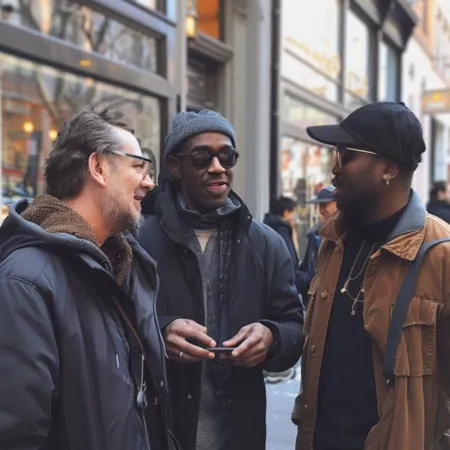Notice how accents differ across the USA? From south to north, they’re all unique, just like the people who have them.
But why do accents matter? They’re like clues about where we’re from and our backgrounds.
Let’s explore the interesting world of American accents.
Key Takeaways
– More Than Just Sound: Accents aren’t just funny ways of saying words. They’re connected to the history and culture of the place, like a secret code.
– Up North (Boston, New York, Philly): Each city has its accent, shaped by its story.
– Down South: The Southern drawl and other accents are like a mix of all the people who lived there before, like African Americans, Native Americans, and Europeans.
– In the Middle (Chicago, Minnesota): The Midwest has many different ways of speaking, from city accents to the more plain way of talking most of the country uses.
– Out West (California, Texas): California’s accent is chill, like the beaches. Texas has a twang, maybe because of cowboys and all the mixed cultures.
4 Types Of Different Accents In America
Think about all the different ways people speak English in the USA.
Every region has its special accent, like a flavor for words. Let’s explore these fun ways of speaking English in America today.
1. Northeastern Accents
Let’s explore American accents in the Northeast. Travel from Boston to New York City and Philadelphia, hearing how people talk in each place.
It will be fun to learn about the unique ways these accents sound and what they tell us about the culture.
A. Boston Accent
The Boston accent! It sounds friendly, like family or chatting with someone you know.
People in Boston have been talking this way for a long time.

The way people talk in Boston is famous, just like seeing the Red Sox play at Fenway Park.
Some folks say it all began with the first people who moved there.
Features
– R-dropping: Ever heard someone say “pahk the cah in Hahvahd Yahd”? That’s the classic Bostonian dropping the letter “r” in words like “park” and “car”.
– Broad A: Words like “bath” and “glass” might sound more like “bahth” and “glahss”, thanks to that unique Boston twist.
– Nasal vowels: People from Boston talk with a funny sound in their nose. It makes their words sound different.
Cultural Associations
The Boston way of talking isn’t just how people sound, it’s a source of pride for locals.
From movies like “Good Will Hunting” to shows like “Cheers“, this accent is famous and reflects the city’s spirit.
But it’s more than just noises. The Boston accent is also connected to Boston’s history and working-class background.
So next time you hear someone with a strong Boston accent, appreciate it.
B. New York Accent
Welcome to the Big Apple, where every borough has its unique flavor, including the accent.
The way people talk in New York is just as varied as in the city itself. Different neighborhoods have their own ways of saying things.
New York accents are everywhere, just like the city itself. Some folks in Brooklyn sound bold and loud, while others in Manhattan seem busy and in a hurry.
Characteristics
– Brooklyn: People in Brooklyn often shorten words and stretch out vowel sounds. For example, they might say “Fuhgeddaboudit” instead of “Forget about it.”
– Bronx: The Bronx has its accent, too. Its speakers make short, choppy sounds and pronounce their vowels uniquely.
– Staten Island: Staten Island combines influences from nearby places. This creates a distinct accent.
C. Philadelphia Accent
Let’s travel down I-95 to Philadelphia, Pennsylvania.
The way people talk in Philly (the accent) differs from other places, and it’s pretty cool.
The Philly accent isn’t just funny sounds. It’s a reminder of the city’s long history and all its neat things, like Rocky and the Liberty Bell.
That’s what makes Philly special.
Features And Background
The Philly accent is special because it says “more wood” instead of “water”. It also stretches some sounds like “youse guys” instead of “you guys.”
It’s like a mix of tough talk and bein’ down-to-earth.
– Pretzel Talk: Want a soft pretzel? In Philly, they might ask for a “wooder” (water) to go with it, because that’s how they say “water” there.
– Jawn: Ever hear someone call everything a “jawn”? That’s a Philly thing, too. It means anything at all.
2. Southern Accents
Let’s discuss South America. Every region has its language, just like different parts of the USA.
A. Southern Drawl
The Southern accent sounds friendly and nice, like cool air on a hot day.
It’s been around for a long time in the Southern US, where big farms and fancy manners were once common.

Imagine relaxing on a swing, drinking sweet tea, and listening to the slow, pretty sounds of Southern talking.
But there’s more to it! The Southern accent isn’t the same everywhere. It’s like a colorful picture with many different parts, each interesting in its own way.
There are many Southern accents, from the gentle way of speaking in Georgia to the twangy way they talk in Mississippi.
B. Appalachian Accent
Let’s travel to the Appalachian mountains! The people there speak especially, and the mountains themselves are special.
The Appalachian way of talking is like a folksy song – simple, real, and interesting.
What makes it different are the ways they say things. It’s been passed down from families who have lived in the mountains for a long time.
Imagine a mix of
– Scottish and Irish roots
– Some Native American influences
– Sprinkle of Southern kindness.
It’s a way of speaking that’s as rich and full of history as the mountains.
C. Influence Of Different Settlers
Southern accents sound interesting, but there’s more to them than just how they sound!
These ways of speaking have a long history, shaped by many different people. African American slaves, Native American groups, and European settlers all played a part.
Think of it like a big band. Each group added its special sound to the music.
The way African Americans speak English with rhythm to the Cherokee way of speaking with high and low tones.
All these influences came together to create the unique Southern accent.
3. Midwestern Accents
Let’s talk about how people speak in the Midwest.
Explore how folks sound in different parts of the region, from big cities to quiet countryside.
A. Chicago Accent
Imagine Chicago! Tall buildings reach for the sky. Busy streets with all kinds of people and a unique way of talking that makes Chicago special.
The Chicago accent is a cool mix of sounds from different countries and cities.

Chicago accent has special sounds, especially for the “A” vowel. Words like “bag” and “flag” might sound more like “beg” and “fleg” to someone who isn’t used to it.
For a long time, many people from different places moved to Chicago. This mix of people has made the way Chicagoans talk unique.
You can hear hints of how people from other places, such as Irish and Polish, speak in the Chicago accent.
Chicago’s history with factories and hard work can be heard in how people talk there.
B. Minnesota Accent
Let’s head up north to Minnesota, the state with lots of lakes. People there talk in a special way that sounds friendly and welcoming.
It’s like when you’re inside a nice cabin in the woods.
One feature of the Minnesota accent is the elongation of vowels. Words like “boat” might sound more like “boooat,” and “bag” could become “baaag.”
This drawn-out speech pattern is often associated with the region’s Scandinavian heritage.
“The way people talk in Minnesota is unique and interesting. They’re known for being friendly and polite; some movies even mock how they sound.
C. General American Accent
We talked about unique ways of speaking in Chicago and Minnesota. But a General American accent is associated with the Midwest.
This way of speaking is like what you hear on TV news and radio. It does not use sounds or words that hide where someone is from.
The general American English accent is how most Americans speak on TV and in movies. It’s clear and easy to understand for everyone in the USA.
How most Americans speak has become more common across the Midwest and other places. Thanks to TV and more people going to school.
Many Midwesterners sometimes use words and sounds from the general American way of speaking.
Even though folks still talk in their ways (regional accents).
4. Western Accents
Now we’re jumpin’ into the world of American Western accents and exploring the cool twangs.
A. Californian Accent
Sunshine, beaches, and movie stars!
People imagine that when they think of California. This easygoing feeling is even in the way Californians talk—relaxed and happy, like a day at the beach.

People in California often speak in a relaxed way. It’s like they’re always on vacation, even in everyday conversations.
This chill way of talking comes from the easygoing lifestyle of the West Coast. And let’s not forget the influence of Hollywood movies.
After all, if you’re around famous actors all the time, you might want to sound laid-back too, right?
But it’s not just about Hollywood. California is a melting pot of cultures, and that diversity flavors the accent, too.
California talk is super varied, just like the people who live there. There are a bunch of different ways people speak.
From slang like “totally awesome” to surfer lingo like “catch that wave,”
B. Texan Accent
The Texan accent is as famous as cowboys riding off into the sunset. It reminds us of the state’s long history and Wild West roots.
Texans are known for speaking with a slow, Southern accent. They often leave out the “g” sound at the end of words.
It’s like a slow Texas two-step in speech form, and it’s as comforting as a warm slice of pecan pie.
The Texas Twang isn’t all about how cowboys talk in movies. It’s a mix of Southern drawl, a bit of Spanish, and some cool confidence, a nod to the state’s rich history.
Whether you’re saying “howdy” or “Buenos días,” the Texan accent welcomes you with open arms and a friendly smile.
Conclusion
We talk in America like a beautiful patchwork quilt with different pieces from everywhere.
From the slow, southern drawl to the quick talking in the Northeast and the relaxed way people speak in the West, our accents show how rich and varied American culture is.
Accents aren’t just sounds; they tell us about the people who speak them. They’re like hints about where someone is from and the people they grew up around.
For Further Research
- Walt Wolfram and Natalie Schilling-Estes’s “American English: Dialects and Variation” explores American dialects and accents in-depth.
- “Speaking American: How Y’all, Youse, and You Guys Talk: A Visual Guide” by Josh Katz illustrates American regional accents and dialects.
- “American English Accent” Chunsheng Yang; Gao Niu; Han Luo. American Speech (2024) 99 (1): 104–115.
- How To Keep The Conversation Going: 12 Expert Tips That Work - December 26, 2024
- Master Speech And Debate: 5 Essential Tips For Success - December 16, 2024
- 11 Communication Quotes To Inspire & Improve Conversations - November 20, 2024

Leave a Reply